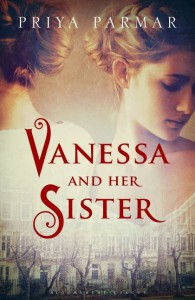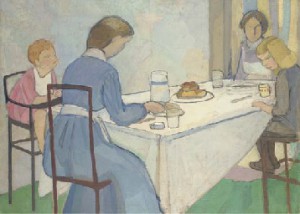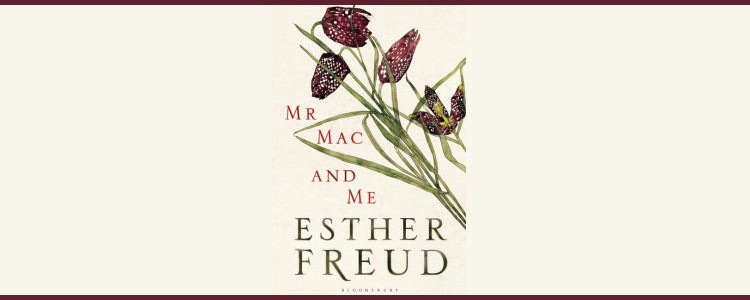Priya Parmar “Vanessa & her Sister”
 26 April 1905 – 46, Gordon Square, Bloomsbury
26 April 1905 – 46, Gordon Square, Bloomsbury
The exhibition opens today. I submitted my portrait of Nelly to the New Gallery over a month ago but never heard whether it was accepted. Mr Bell says that if it had been rejected, they would have sent it back. … .
Later
Virginia set out after breakfast to get a catalogue for the New Gallery. This is Virginia at her best: loving, rational, engaged, sincere.
It was there. We stood in the gallery. Watching people watch the painting. It was exhilarating but mixed with an elusive bittersweet I could not place. Nelly looked lovelier hanging on that wall than she ever did resting on my easel, but she had grown unfamiliar in the weeks since I handed her over to the gallery. It is true that we do not understand the boundaries and dimensions of what we have created until it is consumed by another. I loved being an artist today. (p.28-29)
…
25 August 1906 – Blo’Norton Hall
Now she is writing. Every morning she stands and smokes and writes. She is using her travel desk from home. The wood is worn on the left top corner, where she pulls and paws when she cannot find the right word. Writing settles her. It gives her day a shape, a tempo. I hope she is working on the novel and so can keep her drumbeat rhythm for months and years instead of watching it eddy away as it does after a short article or review.
Priya Parmar’s novel Vanessa and her Sister is about Vanessa Bell and her younger sister Virginia Woolf. It spans a period of seven years ( 1905-12). The four Stephen siblings — Vanessa, Julian, Virginia and Thoby are living together after the recent demise of their parents. Ever so often, Thoby would bring over his friends from Cambridge for a weekly dinner at home in London. Many of these were Cambridge Apostles too who later became better known as members of the Bloomsbury Group. It consisted of Clive Bell, Lytton Stratchey, John Maynard Keynes, Duncan Grant, Roger Fry et al. During these few years, the Bloomsbury Group was established, the first show of Post-Impressionist paintings was curated by Roger Fry in London ( 1910), Vanessa married Clive Bell and discovered what it means to be in a “modern” marriage, Virginia began writing and by 1912 was married to Leonard Woolf who returned to London after his stint as a Civil Servant in Ceylon.
Vanessa and her Sister is written from Vanessa’s point of view. It is in the form of a diary — not an easy mode of writing. It requires the author to be extremely close and familiar with the sensibilities of the person, i.e. Vanessa, writing the diary. As Priya Parmar says about the Bloomsbury Group, “…their lives are so well documented. They were prolific correspondents and diarists, and there is a wealth of existing primary material.” But Vanessa never maintained a diary. This is fiction. In fact the difficulty for the author was to “find enough room for fiction in the negative spaces they left behind”.
Initially Vanessa and her Sister feels like it is a primer about the Bloomsbury group. But then it slowly and very effectively draws you into this  intimate circle of these individuals. A hundred years later these people are still looked up to for their pioneering efforts in art, literature, academics etc. Yet without feeling like an intruder the reader is like a fly on the wall, privy to their conversations, correspondence, emotional outbursts, and affairs/heartbreak. Through it all, slowly and steadily Vanessa plots the professional ( and significant) milestones Virginia and their friends achieve. But what comes through is the quiet “blossoming” of Vanessa, from being the reliable and competent elder sister/wife/mother who is constantly being leaned upon to being professionally successful as a painter. The book closes with her participating with The Nursery Tea in the Second Post-Impressionist Exhibition curated by Roger Fry at the Grafton Galleries, London, 1912.
intimate circle of these individuals. A hundred years later these people are still looked up to for their pioneering efforts in art, literature, academics etc. Yet without feeling like an intruder the reader is like a fly on the wall, privy to their conversations, correspondence, emotional outbursts, and affairs/heartbreak. Through it all, slowly and steadily Vanessa plots the professional ( and significant) milestones Virginia and their friends achieve. But what comes through is the quiet “blossoming” of Vanessa, from being the reliable and competent elder sister/wife/mother who is constantly being leaned upon to being professionally successful as a painter. The book closes with her participating with The Nursery Tea in the Second Post-Impressionist Exhibition curated by Roger Fry at the Grafton Galleries, London, 1912.
2014 has had some spectacular bio-fiction published. Vanessa and her Sister is a good addition to the list. Worth reading!
Priya Parmar Vanessa and her Sister ( In India it is published by Bloomsbury.)
31 Dec 2014




